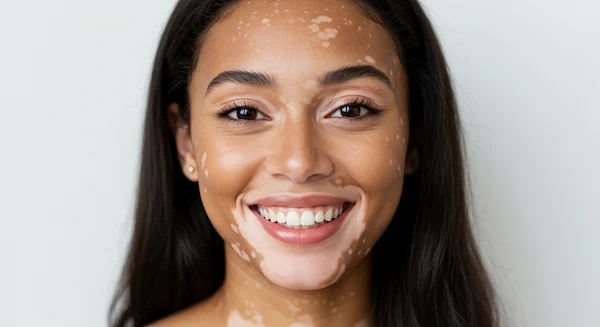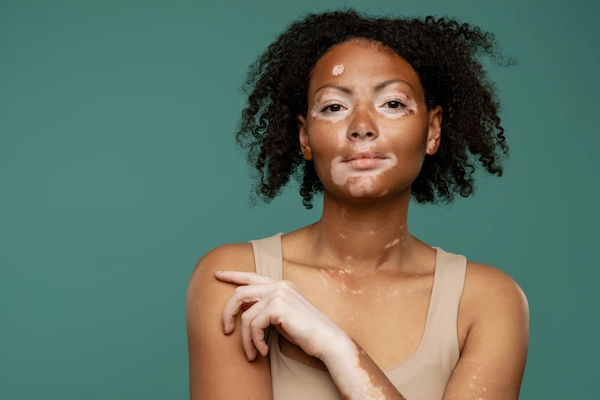What Causes Vitiligo And Its Different Types
Learn what leads to the signs of vitiligo, a condition causing skin pigmentation loss. Explore its underlying causes, risk factors, and different types to understand how it develops and affects the skin.


What is Vitiligo Disease?
Vitiligo is a chronic skin condition in which immune cells mistakenly attack melanocytes, the cells that produce melanin, the pigment that gives skin, hair, and eyes their color. The result is well-defined, lighter or white patches that can appear anywhere, often first seen on the hands, face, or around body openings like the eyes and mouth.
How common is vitiligo? Estimates vary by region and study, but most large sources report a prevalence of about 0.5% to 2% globally. It affects all genders and skin tones equally and can begin at any age, although many people notice signs before age 30. Importantly, vitiligo is not contagious, not caused by “dirt,” and not a sign of poor health. Many people with vitiligo are otherwise healthy.
Vitiligo can be unpredictable. Some people have a few stable patches for years; others notice spread or new spots after triggers like sunburn or friction. While there is no single cure, treatments can stabilize the condition and help repigment skin. The condition is often referred to as a “vitiligo disease” in everyday language, but in medical terms it’s a chronic autoimmune skin disorder. Understanding the types and causes helps you and your dermatologist choose the best plan for you.
What Leads to Signs of Vitiligo?
Here are the root causes and triggers of vitiligo:
Causes:
• Autoimmune attack on melanocytes
Most experts agree vitiligo is primarily an autoimmune condition: the immune system targets melanocytes and the pigment they produce. Researchers have identified immune signals (like interferon-gamma and related pathways) that drive inflammation around hair follicles and melanocytes, leading to pigment loss. This is why many treatments aim to calm immune activity in the skin.
• Genetics and family history
Vitiligo can run in families, although having a relative with vitiligo does not mean you’ll definitely develop it. Dozens of genes have been linked to risk—many tied to immune regulation and melanocyte function. Even so, most cases are “multifactorial,” meaning genetics plus environmental factors shape risk.
• Oxidative stress and environmental factors
Melanocytes are sensitive to oxidative stress—an imbalance between damaging free radicals and protective antioxidants. Oxidative stress can contribute to melanocyte injury and may interact with autoimmunity. This is a leading research area and helps explain why triggers that stress skin can precipitate new patches.
Triggers:
• Sunburn: Significant burns can “unmask” vitiligo in predisposed individuals.
• Friction and pressure: Repeated rubbing (tight straps, seams, watches) or pressure can trigger new patches—a response known as the Koebner phenomenon.
• Chemicals: Certain phenolic compounds in hair dyes and industrial chemicals can induce depigmentation resembling vitiligo (chemical leukoderma).
• Emotional stress: While not a direct cause, stress may flares immune activity and coincide with new or spreading lesions.
Consult Top Specialists
Associated Autoimmune Conditions
People with vitiligo have a higher-than-average chance of other autoimmune diseases, especially autoimmune thyroid disease (Hashimoto’s or Graves’), and less commonly type 1 diabetes, pernicious anemia, or alopecia areata. This doesn’t mean you’ll develop them, but it’s wise to share symptoms or family history with your clinician. If symptoms suggest a thyroid problem (fatigue, weight change, neck swelling), targeted blood tests may be appropriate.
Types of Vitiligo
Understanding vitiligo types helps match expectations and treatments. Here are the different types of vitiligo:
1. Non-segmental vitiligo (NSV)
This is the most common. Patches are typically bilateral and symmetric. Subtypes describe distribution:
• Generalised: Scattered, often symmetric patches across multiple areas.
• Acrofacial: Involves face and extremities first—think early signs of vitiligo on hands, around eyes and mouth.
• Mucosal: Affects mucous membranes (lips, genitals).
• Universal: Extensive involvement (most body surface).
2. Segmental vitiligo (SV)
SV usually affects one side of the body in a segment or stripe-like pattern, often with an early onset. It tends to stabilize earlier than NSV and may respond differently to treatment. Hair whitening in the affected segment is common.
3. Mixed and Unclassified Types
Some people have features of both segmental and non-segmental vitiligo (mixed), or patterns that don’t fit neatly (unclassified).
4. Stable Versus Active Disease
• Active vitiligo: New patches or enlargement of existing ones within the last 6–12 months. Koebner phenomenon may be present.
• Stable vitiligo: No new or expanding patches for 6–12 months. Stability is important because surgical treatments (e.g., skin grafting) are usually reserved for stable disease to improve success and reduce spread [5].
• Clinicians may use the VIDA score (Vitiligo Disease Activity) to track activity.
Recognising the Signs
Early signs often appear where skin is thin or rubbed: fingers and knuckles, backs of hands, elbows, around eyes and mouth, feet and ankles, and body openings. Patches are:
• Well-defined with a sharp border
• Depigmented (chalky white) or lighter than surrounding skin
• Sometimes show a rim of darker pigmentation at the edges
• More noticeable in sun-exposed areas and in darker skin tones
Hair whitening (leukotrichia) may occur in the eyebrows, eyelashes, or scalp in affected areas. Mucosal vitiligo can affect lips or genitals. Under a Wood’s lamp (UVA light), vitiligo lesions often glow a bright blue-white, helping distinguish them from other causes of light patches.
How vitiligo differs from other conditions?
• Tinea versicolor: Caused by yeast; often shows fine scale and may be lighter or darker; usually not sharply depigmented. Responds to antifungals.
• Pityriasis alba: Common in children; faint, ill-defined pale patches on cheeks; usually mild dryness and not completely depigmented.
• Post-inflammatory hypopigmentation: After eczemas or injuries; usually gradually repigments.
• Chemical leukoderma: Related to chemical exposure; distribution may match contact sites.
If new white patches appear or spread, or if you’re unsure what you’re seeing, a dermatologist can help confirm the diagnosis and start timely care. If symptoms persist beyond two weeks or worsen, consult a doctor online with Apollo 24|7 for further evaluation.
Consult Top Specialists
Getting Diagnosed
Diagnosis is mostly clinical—based on how the patches look and where they are.
Dermatology exam, Wood’s lamp, and dermoscopy
• Wood’s lamp: In a dark room, UVA light makes vitiligo appear bright blue-white, highlighting subtle lesions.
• Dermoscopy: A handheld scope can show pigment network changes and “perifollicular” pigment islands that signal repigmentation potential.
• Photos: Baseline and follow-up photos help track changes.
When biopsy or lab tests are used?
• Skin biopsy: Occasionally used if the diagnosis is unclear; in vitiligo, melanocytes are absent in the affected skin.
• Blood tests: No single blood test proves vitiligo. Targeted tests may be ordered if there are symptoms suggesting associated autoimmune conditions, most commonly thyroid disease (TSH, TPO antibodies). Apollo 24|7 offers convenient home collection for tests like thyroid profile, vitamin D, and vitamin B12 when your doctor recommends them.
Screening for thyroid issues—who needs it and when
Routine blanket screening is debated. Many clinicians screen if there are symptoms (fatigue, weight changes, palpitations), a strong family history, or in children where thyroid autoimmunity is relatively more common. Discuss the pros and cons with your dermatologist or primary care doctor.
When to seek care and how to prepare?
• Seek care if you notice new, spreading, or cosmetically distressing patches.
• Bring a list of medications and any exposures (hair dyes, chemicals).
• Note timing of stressors, sun exposure, or friction (e.g., new fitness gear).
• Write down questions about segmental vs nonsegmental vitiligo, treatment options (e.g., NB-UVB phototherapy), and expected timelines.
If your condition does not improve after trying these methods, book a physical visit to a doctor with Apollo 24|7 to personalize your plan.
Treatment Options That Work
There’s no one-size-fits-all treatment. Plans consider type (segmental vs nonsegmental vitiligo), distribution, activity, skin tone, age, and personal goals. Many people benefit from a combination approach.
Topical treatments
• Corticosteroids: Medium-to-high potency steroids can reduce inflammation and encourage repigmentation, especially on the trunk and limbs. They’re often used intermittently to reduce side effects (thinning, stretch marks).
• Calcineurin inhibitors (tacrolimus, pimecrolimus): Useful for face and skin folds where steroids carry higher risk. They can be used longer term and are effective in many cases.
• JAK inhibitors: Ruxolitinib 1.5% cream is approved in several countries for nonsegmental vitiligo in patients 12 years and older. Clinical trials showed significantly higher rates of facial repigmentation compared with placebo over 24–52 weeks, with ongoing gains over time. Ask your dermatologist whether ruxolitinib cream for vitiligo is right for you.
Light-based therapies
• Narrowband UVB (NB-UVB): A first-line option for widespread disease. Delivered in a clinic or, in select cases, via home units under guidance. Treatments are typically 2–3 times per week for several months; repigmentation can take 3–6 months to begin and up to a year for best results.
• Excimer laser (308 nm): Targets small areas; useful for localized patches and in children.
• PUVA (psoralen + UVA): Less commonly used today due to side effects and logistical complexity but can help in selected cases.
Short systemic courses and oral adjuncts
Short courses of oral corticosteroids or other immunomodulators may be used in rapidly progressive disease to halt spread, then transitioned to topical or light therapies. Your clinician will weigh benefits and risks.
Surgery for stable vitiligo
For stable, treatment-resistant patches (stable ≥6–12 months), surgical options include mini-punch grafts, suction blister grafts, and non-cultured epidermal cell suspensions. Best suited for segmental vitiligo or focal areas. Success depends on stability and site.
Depigmentation and camouflage
For very extensive universal vitiligo where repigmentation isn’t feasible, monobenzone (a depigmenting agent) may be considered to even overall skin tone. This is irreversible and a major decision. Medical camouflage (high-coverage cosmetics) offers immediate blending; many find it boosts confidence for events or daily life.
Sun safety as everyday medicine
Depigmented skin burns more easily. Broad-spectrum sunscreen SPF 30+ (ideally 50), sun-protective clothing, and shade help prevent burns and may reduce Koebnerization. Sun care is foundational to any vitiligo plan.
Unique insight: “Combination therapy windows”
Repigmentation often accelerates when you stack modalities thoughtfully—e.g., tacrolimus at night plus NB-UVB 2–3 times weekly, then transition to maintenance once you see perifollicular repigmentation. Think in 12-week “windows” to assess progress and tweak the plan, rather than week-to-week changes.
Daily Care, Diet, and Lifestyle Tips to Protect Your Skin
1. Clothing, friction, and skin-friendly routines
• Choose soft, non-abrasive fabrics; avoid tight straps or seams over active areas to reduce Koebner phenomenon.
• Keep skin moisturised to support barrier function.
• Be mindful of repetitive friction from sports equipment, backpacks, or watches; add padding or adjust fit.
2. Diet, vitamins, and what science says
There’s no proven “vitiligo diet.” Balanced nutrition supports overall skin health. Some clinicians check vitamin D and B12, especially if diets are restricted or in darker-skinned individuals with limited sun exposure. Supplements like antioxidants have mixed evidence; discuss with your doctor before starting. Apollo 24|7 offers home collection for tests like vitamin D or B12 if your clinician recommends checking levels.
3 Stress management and mental well-being
Vitiligo can affect self-image and mood. Mind-body practices (sleep hygiene, exercise, mindfulness), counseling, or peer support groups can help. Evidence suggests that psychological support improves adherence and quality of life, which indirectly supports better skin outcomes.
Special Situations:
• Children and teens
Gentle approaches first: topical calcineurin inhibitors and targeted light (excimer) are common; NB-UVB under supervision is effective. Counseling helps with school and peer interactions. Screening for thyroid disease may be considered based on symptoms or family history.
• Pregnancy and breastfeeding
Many topical treatments (low-to-moderate potency steroids, calcineurin inhibitors) can be used with careful guidance; phototherapy (NB-UVB) is generally considered safe during pregnancy. Always discuss risks/benefits and timing with your obstetrician and dermatologist.
• Skin colour
Vitiligo is often more visually apparent against darker skin, which can intensify social impact. Camouflage techniques and supportive counseling are valuable. Light therapies and topical agents are effective across skin tones; sun safety is crucial to prevent burns and hyperpigmented borders.
Myths, Facts, and Stigma
Common myths
• Myth: Vitiligo is infectious. Fact: It’s not contagious.
• Myth: It only affects people with dark skin. Fact: It affects all skin tones globally.
• Myth: Sunbathing cures it. Fact: Sunburn can worsen vitiligo via Koebnerization.
• Myth: Diet alone can cure vitiligo. Fact: No diet cures vitiligo; nutrition supports overall health.
Addressing stigma
Vitiligo advocacy and role models (athletes, artists) have improved public understanding. For workplaces and schools, a brief explanation plus resources can prevent misconceptions. If stigma affects your mental health, consider counselling—treatment of anxiety or depression can meaningfully improve quality of life and adherence to skin regimens.
Consult Top Specialists
Conclusion
Vitiligo can feel unpredictable, but you have more control than you might think. Understanding the condition—what leads to signs of vitiligo, the major types, and how doctors classify stability—helps you choose treatments confidently and protect your skin day to day. Most care plans combine lifestyle measures (sun safety, friction reduction), topical medicines, and light therapy. Newer options like ruxolitinib cream expand what’s possible, especially for facial repigmentation, and surgical techniques can help in stable, localised disease.
Your plan should fit your goals and life. If you’re seeing early signs on the hands or face, early evaluation improves your options. If you have widespread areas and prefer camouflage or depigmentation, that’s a valid, personal choice. For children and during pregnancy, gentle, evidence-based options exist, and counseling can support confidence at school and work.
If you’re unsure about diagnosis or noticing spread, book a consult—online or in person. If your condition does not improve after trying initial measures, book a physical visit to a doctor with Apollo 24|7 to personalize treatment and consider labs such as thyroid function. Remember: repigmentation takes time. Review progress every 8–12 weeks, adjust the plan with your clinician, and protect your skin consistently. With the right map (type) and a steady approach (activity-based care), many people see meaningful, lasting improvements.
Consult Top Specialists

Dr. S Madhuri
Dermatologist
10 Years • MBBS, MD. DVL, DNB, Fellow (Dermatosurgery & Lasers)
Secunderabad
Apollo Hospitals Secunderabad, Secunderabad
(325+ Patients)

Dr. Bhavya Swarnkar
Dermatologist
14 Years • MBBS, MD, DNB (Dermatology, Venereology & Leprosy) Former Senior Resident, Department of Dermatology- AIIMS, New Delhi. Associate Consultant - Dermatology.
Bilaspur
Apollo Hospitals Seepat Road, Bilaspur
(250+ Patients)

Dr. Sonal Jain
Dermatologist
9 Years • MBBS, MD Dermatology, Venerology & Leprosy
Kolkata
MCR SUPER SPECIALITY POLY CLINIC & PATHOLOGY, Kolkata
(25+ Patients)

Dr. Sonal Jain
Dermatologist
9 Years • MBBS, MD (Skin & VD), DNB (DVL), Fellowship in Dermato Surgery
East Midnapore
VIVEKANANDA SEBA SADAN, East Midnapore

Dr. Kaushiki Hajra
Dermatologist
5 Years • MBBS, MD Dermatology, Venerology & Leprosy
Kolkata
MCR SUPER SPECIALITY POLY CLINIC & PATHOLOGY, Kolkata
Consult Top Specialists

Dr. S Madhuri
Dermatologist
10 Years • MBBS, MD. DVL, DNB, Fellow (Dermatosurgery & Lasers)
Secunderabad
Apollo Hospitals Secunderabad, Secunderabad
(325+ Patients)

Dr. Bhavya Swarnkar
Dermatologist
14 Years • MBBS, MD, DNB (Dermatology, Venereology & Leprosy) Former Senior Resident, Department of Dermatology- AIIMS, New Delhi. Associate Consultant - Dermatology.
Bilaspur
Apollo Hospitals Seepat Road, Bilaspur
(250+ Patients)

Dr. Sonal Jain
Dermatologist
9 Years • MBBS, MD Dermatology, Venerology & Leprosy
Kolkata
MCR SUPER SPECIALITY POLY CLINIC & PATHOLOGY, Kolkata
(25+ Patients)

Dr. Sonal Jain
Dermatologist
9 Years • MBBS, MD (Skin & VD), DNB (DVL), Fellowship in Dermato Surgery
East Midnapore
VIVEKANANDA SEBA SADAN, East Midnapore

Dr. Kaushiki Hajra
Dermatologist
5 Years • MBBS, MD Dermatology, Venerology & Leprosy
Kolkata
MCR SUPER SPECIALITY POLY CLINIC & PATHOLOGY, Kolkata
Consult Top Specialists

Dr. S Madhuri
Dermatologist
10 Years • MBBS, MD. DVL, DNB, Fellow (Dermatosurgery & Lasers)
Secunderabad
Apollo Hospitals Secunderabad, Secunderabad
(325+ Patients)

Dr. Bhavya Swarnkar
Dermatologist
14 Years • MBBS, MD, DNB (Dermatology, Venereology & Leprosy) Former Senior Resident, Department of Dermatology- AIIMS, New Delhi. Associate Consultant - Dermatology.
Bilaspur
Apollo Hospitals Seepat Road, Bilaspur
(250+ Patients)

Dr. Sonal Jain
Dermatologist
9 Years • MBBS, MD Dermatology, Venerology & Leprosy
Kolkata
MCR SUPER SPECIALITY POLY CLINIC & PATHOLOGY, Kolkata
(25+ Patients)

Dr. Sonal Jain
Dermatologist
9 Years • MBBS, MD (Skin & VD), DNB (DVL), Fellowship in Dermato Surgery
East Midnapore
VIVEKANANDA SEBA SADAN, East Midnapore

Dr. Kaushiki Hajra
Dermatologist
5 Years • MBBS, MD Dermatology, Venerology & Leprosy
Kolkata
MCR SUPER SPECIALITY POLY CLINIC & PATHOLOGY, Kolkata
More articles from vitiligo
Frequently Asked Questions
1) Is vitiligo contagious or caused by infection?
No. Vitiligo is an autoimmune condition, not an infection, and it’s not contagious.
2) What are the main types—segmental vs nonsegmental vitiligo?
Nonsegmental vitiligo is most common and appears on both sides of the body; segmental vitiligo affects one side in a band-like pattern and often stabilizes earlier.
3) How is vitiligo diagnosed—do I need a biopsy?
Most diagnoses are clinical, supported by a Wood’s lamp exam. Biopsy is only used when findings are unclear. Targeted labs (e.g., thyroid) may be done if symptoms suggest.
4) Which treatment works best?
It depends on type and activity. Many benefit from topical steroids or calcineurin inhibitors plus NB-UVB phototherapy. Ruxolitinib cream for vitiligo is an option for nonsegmental cases. Stable patches may be candidates for surgical grafting.
5) Should I change my diet or take vitamins?
No diet cures vitiligo. Balanced nutrition helps overall health. Your clinician may check vitamin D or B12 in some cases. Apollo 24|7 offers home collection for these tests if needed.

